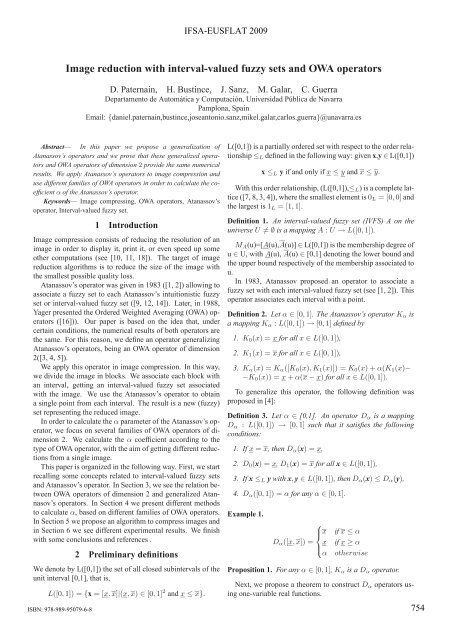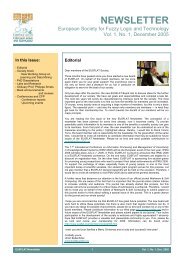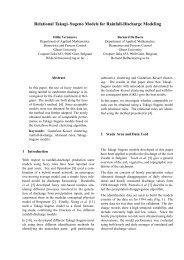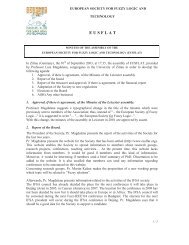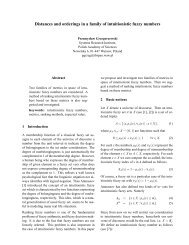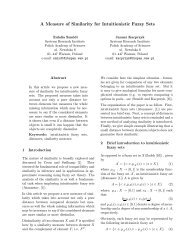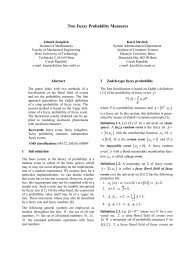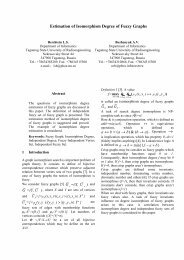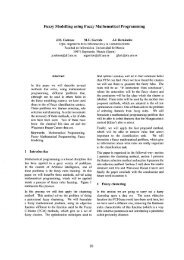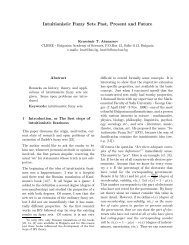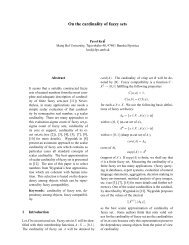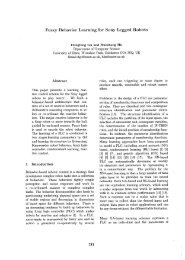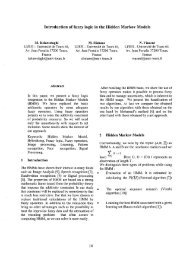Image reduction with interval-valued fuzzy sets and ... - EUSFLAT
Image reduction with interval-valued fuzzy sets and ... - EUSFLAT
Image reduction with interval-valued fuzzy sets and ... - EUSFLAT
You also want an ePaper? Increase the reach of your titles
YUMPU automatically turns print PDFs into web optimized ePapers that Google loves.
<strong>Image</strong> <strong>reduction</strong> <strong>with</strong> <strong>interval</strong>-<strong>valued</strong> <strong>fuzzy</strong> <strong>sets</strong> <strong>and</strong> OWA operators<br />
D. Paternain, H. Bustince, J. Sanz, M. Galar, C. Guerra<br />
Departamento de Automática y Computación, Universidad Pública de Navarra<br />
Pamplona, Spain<br />
Email: {daniel.paternain,bustince,joseantonio.sanz,mikel.galar,carlos.guerra}@unavarra.es<br />
Abstract— In this paper we propose a generalization of<br />
Atanassov’s operators <strong>and</strong> we prove that these generalized operators<br />
<strong>and</strong> OWA operators of dimension 2 provide the same numerical<br />
results. We apply Atanassov’s operators to image compression <strong>and</strong><br />
use different families of OWA operators in order to calculate the coefficient<br />
α of the Atanassov’s operator.<br />
Keywords— <strong>Image</strong> compressing, OWA operators, Atanassov’s<br />
operator, Interval-<strong>valued</strong> <strong>fuzzy</strong> set.<br />
1 Introduction<br />
<strong>Image</strong> compression consists of reducing the resolution of an<br />
image in order to display it, print it, or even speed up some<br />
other computations (see [10, 11, 18]). The target of image<br />
<strong>reduction</strong> algorithms is to reduce the size of the image <strong>with</strong><br />
the smallest possible quality loss.<br />
Atanassov’s operator was given in 1983 ([1, 2]) allowing to<br />
associate a <strong>fuzzy</strong> set to each Atanassov’s intuitionistic <strong>fuzzy</strong><br />
set or <strong>interval</strong>-<strong>valued</strong> <strong>fuzzy</strong> set ([9, 12, 14]). Later, in 1988,<br />
Yager presented the Ordered Weighted Averaging (OWA) operators<br />
([16])). Our paper is based on the idea that, under<br />
certain conditions, the numerical results of both operators are<br />
the same. For this reason, we define an operator generalizing<br />
Atanassov’s operators, being an OWA operator of dimension<br />
2([3, 4, 5]).<br />
We apply this operator in image compression. In this way,<br />
we divide the image in blocks. We associate each block <strong>with</strong><br />
an <strong>interval</strong>, getting an <strong>interval</strong>-<strong>valued</strong> <strong>fuzzy</strong> set associated<br />
<strong>with</strong> the image. We use the Atanassov’s operator to obtain<br />
a single point from each <strong>interval</strong>. The result is a new (<strong>fuzzy</strong>)<br />
set representing the reduced image.<br />
In order to calculate the α parameter of the Atanassov’s operator,<br />
we focus on several families of OWA operators of dimension<br />
2. We calculate the α coefficient according to the<br />
type of OWA operator, <strong>with</strong> the aim of getting different <strong>reduction</strong>s<br />
from a single image.<br />
This paper is organized in the following way. First, we start<br />
recalling some concepts related to <strong>interval</strong>-<strong>valued</strong> <strong>fuzzy</strong> <strong>sets</strong><br />
<strong>and</strong> Atanassov’s operator. In Section 3, we see the relation between<br />
OWA operators of dimension 2 <strong>and</strong> generalized Atannasov’s<br />
operators. In Section 4 we present different methods<br />
to calculate α, based on different families of OWA operators.<br />
In Section 5 we propose an algorithm to compress images <strong>and</strong><br />
in Section 6 we see different experimental results. We finish<br />
<strong>with</strong> some conclusions <strong>and</strong> references .<br />
2 Preliminary definitions<br />
We denote by L([0,1]) the set of all closed sub<strong>interval</strong>s of the<br />
unit <strong>interval</strong> [0,1], that is,<br />
L([0, 1]) = {x =[x, x]|(x, x) ∈ [0, 1] 2 <strong>and</strong> x ≤ x}.<br />
ISBN: 978-989-95079-6-8<br />
IFSA-<strong>EUSFLAT</strong> 2009<br />
L([0,1]) is a partially ordered set <strong>with</strong> respect to the order relationship<br />
≤L defined in the following way: given x,y ∈ L([0,1])<br />
x ≤L y if <strong>and</strong> only if x ≤ y <strong>and</strong> x ≤ y.<br />
With this order relationship, (L([0,1]),≤L) is a complete lattice<br />
([7, 8, 3, 4]), where the smallest element is 0L =[0, 0] <strong>and</strong><br />
the largest is 1L =[1, 1].<br />
Definition 1. An <strong>interval</strong>-<strong>valued</strong> <strong>fuzzy</strong> set (IVFS) A on the<br />
universe U = ∅ is a mapping A : U → L([0, 1]).<br />
MA(u)=[A(u),A(u)] ∈ L([0,1]) is the membership degree of<br />
u ∈ U, <strong>with</strong> A(u), A(u) ∈ [0,1] denoting the lower bound <strong>and</strong><br />
the upper bound respectively of the membership associated to<br />
u.<br />
In 1983, Atanassov proposed an operator to associate a<br />
<strong>fuzzy</strong> set <strong>with</strong> each <strong>interval</strong>-<strong>valued</strong> <strong>fuzzy</strong> set (see [1, 2]). This<br />
operator associates each <strong>interval</strong> <strong>with</strong> a point.<br />
Definition 2. Let α ∈ [0, 1]. The Atanassov’s operator Kα is<br />
a mapping Kα : L([0, 1]) → [0, 1] defined by<br />
1. K0(x) =x for all x ∈ L([0, 1]),<br />
2. K1(x) =x for all x ∈ L([0, 1]),<br />
3. Kα(x) =Kα([K0(x),K1(x)]) = K0(x)+α(K1(x)−<br />
−K0(x)) = x + α(x − x) for all x ∈ L([0, 1]).<br />
To generalize this operator, the following definition was<br />
proposed in [4]:<br />
Definition 3. Let α ∈ [0,1]. An operator Dα is a mapping<br />
Dα : L([0, 1]) → [0, 1] such that it satisfies the following<br />
conditions:<br />
1. If x = x, thenDα(x) =x,<br />
2. D0(x) =x, D1(x) =x for all x ∈ L([0, 1]),<br />
3. If x ≤L y <strong>with</strong> x, y ∈ L([0, 1]), thenDα(x) ≤ Dα(y),<br />
4. Dα([0, 1]) = α for any α ∈ [0, 1].<br />
Example 1.<br />
⎧<br />
⎪⎨ x if x ≤ α<br />
Dα([x, x]) = x<br />
⎪⎩<br />
α<br />
if x ≥ α<br />
otherwise<br />
Proposition 1. For any α ∈ [0, 1], Kα is a Dα operator.<br />
Next, we propose a theorem to construct Dα operators using<br />
one-variable real functions.<br />
754
Theorem 1. Let α ∈ [0, 1] <strong>and</strong> let f :[0, 1] → [0, 1] be a<br />
continuous <strong>and</strong> strictly increasing function. Then the operator<br />
Dα : L([0, 1]) → [0, 1] given by<br />
Dα(x) =f −1<br />
<br />
<br />
pf(x)+(1−p)f(x) <strong>with</strong> p = f(1)−f(α)<br />
f(1)−f(0) ,isaDα operator in the sense of Definition<br />
3.<br />
Proof:<br />
1. If x = x,thenDα(x) =f −1 (pf(x)+(1− p)f(x)) =<br />
= f −1 (f(x)) = x.<br />
2. If α =0,thenp =1. In these conditions D0([x, x]) =<br />
= f −1 (f(x)) = x.<br />
If α =1,thenp =0<strong>and</strong> therefore D1([x, x]) = x.<br />
3. If [x, x] ≤L [y, y], as f is continuous <strong>and</strong> strict, we<br />
have that Dα([x, x]) = f −1 (pf(x) +(1− p)f(x)) ≤<br />
f −1 (pf(y)+(1− p)f(y)) = Dα([y, y]).<br />
4. If x =[0, 1], then<br />
Dα([0, 1]) = f −1 (p(f(0) + (1 − p)f(1)) =<br />
) =<br />
f −1 ( f(0)(f(1)−f(α))−f(1)(f(1)−f(α))+f(1)(f(1)−f(0))<br />
f(1)−f(0)<br />
f −1 ( f(α)(f(1)−f(0))<br />
f(1)−f(0) )=α.<br />
Remark: In this paper, we take f(x) =x. Under this condition,<br />
by Theorem 1, we have that<br />
Dα([x, x]) = x + α(x − x) =Kα([x, x])<br />
3 Kα <strong>and</strong> OWA operators<br />
In [16], Yager introduced the Ordered Weighted Aggregation<br />
Operator (OWA operator) in the following way:<br />
Definition 4. A mapping F : [0, 1] n → [0, 1] is called an<br />
OWA operator of dimension n if there exists a weighting vector<br />
W ,W = (w1,w2,...,wn) ∈ [0, 1] n <strong>with</strong> <br />
i wi = 1 <strong>and</strong><br />
such that<br />
n<br />
F (a1,a2,...,an) =<br />
<strong>with</strong> bj the j-th largest of the ai.<br />
j=1<br />
wjbj<br />
In the original definition, Yager considered the OWA operators<br />
as a mapping from the whole euclidean space R n to<br />
R. However, for us it is better to reduce the domain only to<br />
[0, 1] 2 .<br />
There exist three important special cases of OWA operators<br />
that coincide <strong>with</strong> well known aggregation functions, as we<br />
canseein[17].<br />
1. F ∗ : The weighting vector, denoted as W ∗ , is defined as<br />
w1 =1<strong>and</strong> wj =0for all j = 1.<br />
F ∗ (a1,...,an) =max{a1,...,an}<br />
2. F∗: The weighting vector, denoted as W∗, is defined as<br />
wn =1<strong>and</strong> wj =0for all j = n.<br />
F∗(a1,...,an) =min{a1,...,an}.<br />
3. FA: The weighting vector, denoted as WA, is defined as<br />
wj =1/n for all j ∈<br />
<br />
1,...,n.<br />
n<br />
i=1 ai.<br />
FA(a1,...,an) = 1<br />
n<br />
ISBN: 978-989-95079-6-8<br />
IFSA-<strong>EUSFLAT</strong> 2009<br />
If we focus on two-dimensional OWA operators using as<br />
weighting vector W = (α, 1 − α), we can think of applying<br />
it to the bounds of an <strong>interval</strong>. In this case, the numerical<br />
result of applying the OWA operator on the bounds of an <strong>interval</strong><br />
<strong>and</strong> the operator Dα acting on that <strong>interval</strong> is the same.<br />
While Dα operator acts over elements in L([0,1]), the domain<br />
of OWA operators is [0,1]x[0,1]. For this reason, OWA operators<br />
acting on the unit square require an ordering operation to<br />
ensure the elements to be the extremes of an <strong>interval</strong> defined<br />
in L([0,1]). That’s the reason why we need the following theorems<br />
to study the relationship between these operators.<br />
We define a new operator Dα by composing the Dα operator<br />
<strong>with</strong> the map<br />
i :[0, 1] 2 → L([0, 1])<br />
(x, y) → [min(x, y),max(x, y)]<br />
Theorem 2. 1. Let α ∈ [0, 1] <strong>and</strong> D = Dα ◦ i where Dα<br />
is the operator given in Definition 3. Then, if F is the<br />
OWA operator (of dimension 2) defined by the weighting<br />
vector W =(α, 1 − α), we have that<br />
Dα(x, y) =F (x, y) for all x, y ∈ [0, 1].<br />
2. Let F be an OWA operator (of dimension 2) <strong>with</strong> weighting<br />
vector W =(w1,w2). Then for any (x, y) ∈ [0, 1] 2<br />
we have that<br />
F (x, y) =Dα(x, y), <strong>with</strong> α = w1.<br />
4 Calculation methods for α coefficient<br />
In this section, we study how to calculate the α coefficient<br />
basing on different families of OWA operators. First, we study<br />
two measures defined in [17] <strong>and</strong> associated <strong>with</strong> any OWA<br />
operator: the orness <strong>and</strong> the dispersion.<br />
Definition 5. Let F be an OWA operator <strong>and</strong> W its weighting<br />
vector. The orness measure is defined as<br />
orness(F )=<br />
1<br />
(n − 1)<br />
n<br />
(n − i)wi.<br />
i=1<br />
With this definition it is easy to see that orness(F ∗ )=1,<br />
orness(F∗) =0<strong>and</strong> orness(FA) =0.5.<br />
Proposition 2. orness(Dα) =α<br />
Proof:<br />
orness(Dα(x)) = 1<br />
2<br />
(2 − i)wi = w1 = α<br />
2 − 1<br />
i=1<br />
Definition 6. Let F be an OWA operator <strong>and</strong> W its weighting<br />
vector. The dispersion measure is defined as<br />
n<br />
Disp(F )=− wilnwi.<br />
i=1<br />
Proposition 3. Disp(Dα) =αln( 1−α<br />
α )+ln(1 − α)<br />
Proof:<br />
Disp(Dα) =− 2<br />
i=1 wilnwi =<br />
= α(ln(1 − α) − ln(α)) − ln(1 − α) =<br />
= αln( 1−α<br />
α )+ln(1 − α)<br />
755
Next, it is shown the relation between the coefficient α of<br />
the operator Dα <strong>and</strong> some families of OWA operators.<br />
Definition 7. F is called a ME-OWA operator if F is an OWA<br />
operator such that given a desired value of orness β, itmaximizes<br />
the dispersion (entropy). In particular we solve the following<br />
problem:<br />
Max − n i=1 wilnwi<br />
subject to β =1/(n− 1) n i=1 (n − i)wi<br />
n where<br />
i=1 wi =1, wi ∈ [0, 1].<br />
Proposition 4. The operator Dα is a ME-OWA for all α ∈<br />
[0, 1], <strong>with</strong> orness(Dα) =α.<br />
Definition 8. F is called a generalized S-OWA operator if F<br />
is an OWA operator where<br />
(1 − (a + b)),<br />
(1 − (a + b)), <strong>with</strong> i =2,...,n− 1,<br />
(1 − (a + b)).<br />
<strong>with</strong> a, b ∈ [0, 1] <strong>and</strong> a + b ≤ 1.<br />
Proposition 5. Let a, b ∈ [0, 1] such that a+b ≤ 1. Ifwetake<br />
w1 = a + 1<br />
n<br />
wi = 1<br />
n<br />
wn = b + 1<br />
n<br />
1+a − b<br />
α =<br />
2<br />
then Dα is a generalized S-OWA operator.<br />
Definition 9. F is called a BADD-OWA operator if F is an<br />
OWA operator where<br />
wi =<br />
b β<br />
i<br />
n j=1 bβ j<br />
<strong>with</strong> β ≥ 0 <strong>and</strong> being bi as in Definition 4.<br />
Proposition 6. Let β ≥ 0. Ifwetake<br />
α =<br />
(D1(x, y)) β<br />
(D0(x, y)) β +(D1(x, y)) β<br />
<strong>with</strong> x, y ∈ [0, 1], thenDαis a BADD-OWA operator.<br />
Definition 10. Let β ≥ 0. F is called a modified BADD-OWA<br />
operator if F is an OWA operator where<br />
1. wi = (1/bi)β<br />
n<br />
j=1 (1/bj)β or<br />
2. wi = (1−bi)β<br />
n<br />
j=1 (1−bj)β or<br />
3. wi = 1<br />
n−1<br />
4. wi = (bn−i+1)β<br />
(1 − bβ<br />
i<br />
n<br />
n<br />
j=1 bβ<br />
j<br />
j=1 bβ<br />
j<br />
) or<br />
being bi as in Definition 4.<br />
Proposition 7. Let β ≥ 0. The following items are satisfied:<br />
1. If we take<br />
α =<br />
=1−<br />
(1/D1(x,y)) β<br />
(1/D1(x,y)) β +(1/D0(x,y)) β =<br />
(D1(x,y)) β<br />
(D1(x,y)) β +(D0(x,y)) β (D0(x,y))<br />
=<br />
β<br />
(D1(x,y)) β +(D0(x,y)) β<br />
then Dα is a modified BADD-OWA operator in the sense<br />
ofitems1,3y4ofDefinition 10.<br />
ISBN: 978-989-95079-6-8<br />
IFSA-<strong>EUSFLAT</strong> 2009<br />
2. If we take<br />
α =<br />
(1 − D1(x, y)) β<br />
(1 − D1(x, y)) β +(1− D0(x, y)) β<br />
then Dα is a modified BADD-OWA operator in the sense<br />
of item 2 of Definition 10.<br />
Proof:<br />
1. Obviously, taking into account items 1,3 <strong>and</strong> 4 of Definition<br />
10 <strong>and</strong> that Dα is an OWA operator of dimension<br />
2.<br />
2. Direct .<br />
5 <strong>Image</strong> <strong>reduction</strong><br />
We consider an image Q as a N × M matrix. Each coordinate<br />
of the pixels in the image Q is denoted as (i, j). The intensity<br />
or gray level of the pixel located in (i, j) is represented as qij,<br />
<strong>with</strong> 0 ≤ qij ≤ L − 1 for each (i, j) ∈ Q.<br />
In our approach to image <strong>reduction</strong> we use <strong>interval</strong>-<strong>valued</strong><br />
<strong>fuzzy</strong> <strong>sets</strong> <strong>and</strong> Dα operator. It has been shown (see [13, 6,<br />
15]) that <strong>interval</strong>-<strong>valued</strong> <strong>fuzzy</strong> <strong>sets</strong> used in images allow the<br />
development of algorithms in several topics as edge detecion,<br />
contrast or thresholding <strong>with</strong> very good results. We propose<br />
the following algorithm:<br />
1. Divide the image Q in blocks of size n × n. IfMor N<br />
are not multiple of n, we delete the minimum number of<br />
rows/columns in the boundary of the image until the new<br />
size of the image satisfies the property.<br />
2. Associate each block <strong>with</strong> an <strong>interval</strong> in the following<br />
way: the lower bound of the <strong>interval</strong> is given by the minimum<br />
of the intensities in the block <strong>and</strong> the upper bound<br />
by the maximum.<br />
3. Choose the α parameter in the operator Dα.<br />
4. Associate each <strong>interval</strong> <strong>with</strong> the number obtained after<br />
applying the operator Dα.<br />
Example: Let Q be a matrix of dimension 6 × 6 <strong>and</strong> let<br />
n =3<br />
⎛<br />
⎞<br />
q1,1 q1,2 q1,3 q1,4 q1,5 q1,6<br />
⎜ q2,1 q2,2 q2,3 q2,4 q2,5 q2,6 ⎟<br />
⎜<br />
⎟<br />
⎜ q3,1 q3,2 q3,3 q3,4 q3,5 q3,6 ⎟<br />
⎜<br />
⎟<br />
⎜ q4,1 q4,2 q4,3 q4,4 q4,5 q4,6 ⎟<br />
⎜<br />
⎟<br />
⎝<br />
⎠<br />
q5,1 q5,2 q5,3 q5,4 q5,5 q5,6<br />
q6,1 q6,2 q6,3 q6,4 q6,5 q6,6<br />
Then, the <strong>interval</strong>-<strong>valued</strong> <strong>fuzzy</strong> set associated <strong>with</strong> Q is<br />
formed by 4 elements:<br />
⎛<br />
⎜<br />
⎝<br />
⎡<br />
⎣<br />
<br />
i=1,2,3<br />
qi,j<br />
⎡<br />
⎣<br />
j=1,2,3<br />
<br />
qi,j<br />
i=4,5,6<br />
j=1,2,3<br />
⎤<br />
qi,j ⎦<br />
i=1,2,3<br />
j=1,2,3<br />
⎤<br />
qi,j ⎦<br />
i=4,5,6<br />
j=1,2,3<br />
⎡<br />
⎣<br />
<br />
i=1,2,3<br />
qi,j<br />
⎡<br />
⎣<br />
j=4,5,6<br />
<br />
qi,j<br />
i=4,5,6<br />
j=4,5,6<br />
⎤<br />
qi,j ⎦<br />
i=1,2,3<br />
j=4,5,6<br />
⎤<br />
qi,j ⎦<br />
i=4,5,6<br />
j=4,5,6<br />
⎞<br />
⎟<br />
⎠<br />
Remark:Notice that the symbols ∧ <strong>and</strong> ∨ st<strong>and</strong> for minimum<br />
<strong>and</strong> maximum respectively.<br />
Once the <strong>interval</strong>-<strong>valued</strong> <strong>fuzzy</strong> set associated <strong>with</strong> the image<br />
has been obtained, we build a <strong>fuzzy</strong> set. Applying the<br />
operator Dα to each <strong>interval</strong> we get the reduced image of size<br />
2 × 2.<br />
756
Figure 1: Original <strong>Image</strong> Lena<br />
Figure 2: Original image Cameraman<br />
6 Experimental results<br />
In this section we use the algorithm proposed in Section 5. Using<br />
the relation between the operator Dα <strong>and</strong> OWA operators<br />
of dimension 2, we propose several methods of calculating the<br />
α coefficient based on families of OWA operators.<br />
We get two different situations according to the OWA operator<br />
used. In the first one, the value of α is constant for the<br />
whole image. This situation happens <strong>with</strong> ME-OWA operators<br />
<strong>and</strong> generalized S-OWA operators, due to their definition.<br />
In the second one, the value of α depends on the bounds of<br />
each <strong>interval</strong>, so its value varies for each block. This happens<br />
when we take BADD-OWA operators <strong>and</strong> modified BADD-<br />
OWA operators.<br />
The tests of this section have been made <strong>with</strong> the image<br />
Lena (Figure 1) <strong>and</strong> Cameraman (Figure 2). The size of the<br />
block is n =3(submatrices 3 × 3). In this way, the size of the<br />
reduced image is 9 times smaller than the original.<br />
With α =0, we associate the lower bound of the <strong>interval</strong><br />
to each block. With α =0.5, we take the mean point of the<br />
<strong>interval</strong>. Finally, <strong>with</strong> α =1, we associate the upper bound of<br />
the <strong>interval</strong>.<br />
Obviously, the higher the value of α, the higher the membership<br />
degree <strong>and</strong> therefore the intensity of the image. The<br />
image is darker <strong>with</strong> α =0than <strong>with</strong> α =0.5, which is also<br />
darker than <strong>with</strong> α =1.<br />
α =0 α =0.5 α =1<br />
Figure 3: Reduction using ME-OWA operators<br />
6.1.2 Reduction <strong>with</strong> generalized S-OWA operator<br />
To construct a generalized S-OWA operator, it is necessary, as<br />
we have seen in Definition 8, the election of two parameters<br />
a, b ∈ [0, 1] such that a + b ≤ 1. If we focus on the contribution<br />
of the parameters in the S-OWA operator, we can study<br />
several possibilities:<br />
1. If a = b, thenwehavethatα =0.5, getting the average<br />
of the bounds of the <strong>interval</strong>.<br />
2. If a =1<strong>and</strong> b =0,wegetα =1.<br />
3. If a =0<strong>and</strong> b =1,wegetα =0.<br />
4. If a + bb, the upper bound of<br />
the <strong>interval</strong> is predominant over the lower bound, while<br />
when ab, the importance is given to the upper<br />
bound of the <strong>interval</strong>, getting a value of α =0.625. If<br />
we increase the value of a, then α tends to 1. For example,<br />
if we take a =0.9,b =0,thenα =0.95. With this value<br />
of α we get a reduced image very similar to the images studied<br />
in the last column of Figure 3. On the other side, if we<br />
take a =0.25,b =0.5, we get a value of α =0.375. Ifwe<br />
increase the value of b, α → 0. We can see this if we take<br />
a =0,b =0.9 (α =0.05). Notice that as α increase, the<br />
image becomes lighter.<br />
6.1 Calculation <strong>with</strong> constant α<br />
In this section we use ME-OWA operators <strong>and</strong> generalized S-<br />
OWA to calculate a constant value of α for the whole image.<br />
Once the value has been calculated, we apply the Dα operator<br />
to each <strong>interval</strong> in the image.<br />
6.2 Calculation <strong>with</strong> variable α<br />
6.1.1 Reduction <strong>with</strong> ME-OWA operators<br />
In this section, the value of α is calculated by means of the<br />
As we have seen in Section 4, the construction of ME-OWA bounds of the <strong>interval</strong>. This means that the value of α is<br />
operators is direct. For this reason, we analyze three specific variable. For this reason we use BADD-OWA <strong>and</strong> modified<br />
cases: α =0, α =0.5<strong>and</strong> α =1.<br />
BADD-OWA operators.<br />
ISBN: 978-989-95079-6-8<br />
IFSA-<strong>EUSFLAT</strong> 2009<br />
757
a=0,b=0.9 a=0.25,b=0.5 a=0.5,b=0.25 a=0.9,b=0<br />
α =0.05 α =0.375 α =0.625 α =0.95<br />
Figure 4: Reduction using generalized S-OWA operators<br />
6.2.1 Reduction <strong>with</strong> BADD-OWA operators<br />
As we see in Definition 9, to construct a BADD-OWA operator<br />
it is necessary to select a value of β ≥ 0. We know that<br />
if we take β =0,thenwegetα =0.5, already studied in<br />
Section 6.1.1. In other case, if we take β =1,thevalueofα<br />
is calculated as follows:<br />
α = x<br />
x + x<br />
being [x, x] ∈ L([0, 1]) the <strong>interval</strong> representing each block.<br />
We also know that α ≥ 0.5, <strong>and</strong> if we increase the value of<br />
β, α → 1. That is, the result tends to the upper bound of<br />
the <strong>interval</strong>. For this reason, <strong>with</strong> a high value of β, weget<br />
reduced images similar as the images analyzed in third column<br />
of Figure 3.<br />
β =1 β =10 β =20 β = 100<br />
Figure 5: Reduction using BADD-OWA operators<br />
6.3 Reduction <strong>with</strong> modified BADD-OWA operators<br />
If we use modified BADD-OWA operators, bearing in mind<br />
items 1 <strong>and</strong> 2 of Proposition 7, we can take two different expressions<br />
for α. As we have analyzed in BADD-OWA operators,<br />
the value of α depends on the <strong>interval</strong> <strong>and</strong> on the β<br />
parameter. As in Section 6.2.1, if β =0,thenα =0.5.<br />
Under conditions of item 1 of Proposition 7 <strong>and</strong> taking β =<br />
1, thevalueofα is as follows:<br />
α = x<br />
x + x<br />
being [x, x] ∈ L([0, 1]) the <strong>interval</strong> representing each block.<br />
In this case, α ≤ 0.5 <strong>and</strong> as β increases, α → 0 when β →∞<br />
(notice that the image becomes darker as β increases <strong>and</strong> α<br />
decreases).<br />
ISBN: 978-989-95079-6-8<br />
IFSA-<strong>EUSFLAT</strong> 2009<br />
β =1 β =10 β =20 β = 100<br />
Figure 6: Reduction using modified BADD-OWA operators<br />
(item 1)<br />
If we base on item 2 of Proposition 7, for β =1, α is as<br />
follows:<br />
1 − x<br />
α =<br />
(1 − x)+(1−x) being [x, x] ∈ L([0, 1]) the <strong>interval</strong> representing each block.<br />
In this case, the value of α also decreases when β increases.<br />
β =1 β =10 β =20 β = 100<br />
Figure 7: Reduction using modified BADD-OWA operators<br />
(item 2)<br />
7 Conclusions <strong>and</strong> future research<br />
In this paper, we have proved that we can obtain OWA operators<br />
of dimension 2 from Atanassov’s operators. This fact has<br />
allowed us to use several families of OWA operators to get Dα<br />
operators for image <strong>reduction</strong>.<br />
Some future lines of research can be:<br />
1. Compare the different <strong>reduction</strong>s obtained according to<br />
the value of α.<br />
2. Compare our results <strong>with</strong> other <strong>reduction</strong> algorithms.<br />
3. Consider different methods of reconstruction of the original<br />
image from the reduced one. Analyze which of the<br />
reduced images leads to the best reconstructed image.<br />
Acknowledgment - This paper has been partially supported<br />
by the National Science Foundation of Spain, Reference<br />
TIN2007-65981.<br />
758
References<br />
[1] K. Atanassov, Intuitionistic <strong>fuzzy</strong> <strong>sets</strong>, In: VIIth ITKR Session,<br />
Deposited in the Central Science <strong>and</strong> Technology Library of<br />
the Bulgarian Academy of Sciences, Sofia, Bulgaria, 1983, pp.<br />
1684-1697.<br />
[2] K. Atanassov, Intuitionistic <strong>fuzzy</strong> <strong>sets</strong>, Fuzzy Sets <strong>and</strong> Systems<br />
20 (1986) 87-96.<br />
[3] H. Bustince, E. Barrenechea, M. Pagola, Generation Of<br />
Interval-Valued Fuzzy And Atanassov’s Intuitionistic Fuzzy<br />
Connectives From Fuzzy Connectives And From K(Alpha)<br />
Operators. Laws For Conjunctions And Disjunctions. Amplitude,<br />
International Journal of Intelligent Systems (2008) In<br />
Press<br />
[4] H. Bustince, J. Montero, M. Pagola, E. Barrenechea, D. Gmez:<br />
A Survey On Interval-Valued Fuzzy Sets. In W. Pedrycz, A.<br />
Skowron, V. Kreinovichedrycz (Eds.): H<strong>and</strong>book of Granular<br />
Computing John Wiley <strong>and</strong> sons, NewYork, (2008), Chapter<br />
22.<br />
[5] H. Bustince, J. Montero, E. Barrenechea, M. Pagola, Laws of<br />
Conjunctions <strong>and</strong> Disjunctions in Interval type 2 <strong>fuzzy</strong> <strong>sets</strong>.<br />
In: Proc. IEEE World Congress on Computational Intelligence,<br />
WCCI2008 , Hong Kong, 2008.<br />
[6] T. Chaira, A.K. Ray, A new measure using intuitionistic <strong>fuzzy</strong><br />
set theory <strong>and</strong> its application to edge detection, Applied Soft<br />
Computing 8(2) (2008) 919-927.<br />
[7] C. Cornelis, G. Deschrijver, E.E. Kerre, Advances <strong>and</strong> challenges<br />
in <strong>interval</strong>-<strong>valued</strong> <strong>fuzzy</strong> logic, Fuzzy Sets <strong>and</strong> Systems<br />
157 (2006) 622-627.<br />
[8] G. Deschrijver,C. Cornelis, E.E. Kerre, On the representation<br />
of intuitionistic <strong>fuzzy</strong> T-norms <strong>and</strong> T-conorms, IEEE Transactions<br />
on Fuzzy Systems 12(1) (2004) 45-61.<br />
[9] M.B. Gorzalczany, A method of inference in approximate reasoning<br />
based on <strong>interval</strong>-<strong>valued</strong> <strong>fuzzy</strong> <strong>sets</strong>, Fuzzy Sets <strong>and</strong> Systems<br />
21 (1987) 1-17.<br />
[10] E. Karabasssis, M. E. Spektsakis, An analysis of image interpolation,<br />
differentiation <strong>and</strong> <strong>reduction</strong> using local polynomial<br />
fits, Graphical models <strong>and</strong> image processing, 57 (3), (1995)<br />
183-1995.<br />
[11] H. Nobuhara, W. Pedrycz, S. Sessa, K. Hirota, A motion compression/reconstruction<br />
method based on max t-norm composite<br />
<strong>fuzzy</strong> relational equations, Information Sciences 176 (2006)<br />
2526-2552.<br />
[12] R. Sambuc, Function Φ-Flous, Application a l’aide au Diagnostic<br />
en Pathologie Thyroidienne, These de Doctorat en<br />
Medicine, University of Marseille (1975).<br />
[13] H.R. Tizhoosh, <strong>Image</strong> thresholding using type-2 <strong>fuzzy</strong> <strong>sets</strong>,<br />
Pattern Recognition 38 (2005) 2363-2372.<br />
[14] I. B. Turksen, Interval <strong>valued</strong> <strong>fuzzy</strong> <strong>sets</strong> based on normal<br />
forms, Fuzzy Sets <strong>and</strong> Systems 20(2) (1986) 191-210.<br />
[15] I.K. Vlachos, G.D. Sergiadis, Intuitionistic <strong>fuzzy</strong> information<br />
- Applications to pattern recognition, Pattern Recognition Letters<br />
28(2) (2007) 197-206.<br />
[16] R.R. Yager, On ordered weighted averaging aggregation operators<br />
in multicriteria decisionmaking, IEEE Trans. Syst. Man<br />
Cybern, 18 (1988) 183-190.<br />
ISBN: 978-989-95079-6-8<br />
IFSA-<strong>EUSFLAT</strong> 2009<br />
[17] R.R. Yager, Families of OWA operators, Fuzzy Sets <strong>and</strong> Systems,<br />
59 (1993) 125-148.<br />
[18] G. Y. Yang, H.Z. Shu, C. Toumoulin, G.N. Han, L.M. Luo,<br />
Efficient Legendre moment computation for grey level images,<br />
Pattern Recognition, 39 (2006) 74-80.<br />
759


